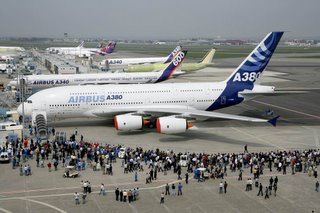SPONSORED
 A380, WORLD'S LARGEST COMMERCIAL AIRCRAFT, SUCCESSFULLY TAKES TO THE SKIES
A380, WORLD'S LARGEST COMMERCIAL AIRCRAFT, SUCCESSFULLY TAKES TO THE SKIES
Aviation history was made this morning when the first A380, the world's largest commercial aircraft, successfully took off on its maiden flight leaving Blagnac International Airport in Toulouse, France at 10.29 hours local time (08.29 UTC) from runway 32L. The A380 first flight will take place above the region west of Toulouse and South West France.
The A380's first flight is being jointly captained by Claude Lelaie, Senior Vice President of Airbus' Flight Division and Chief Test Pilot and Vice President Jacques Rosay. The other crew members are Fernando Alonso, Vice President Flight Division, Flight Test Engineering, who leads a team of two other flight test engineers Jacky Joye and Manfred Birnfeld, and test flight engineer Gérard Desbois.
For its first flight, Airbus' 21st century flagship, carrying the registration F-WW0W, took off at a weight of 421 tonnes / 928,300 lbs, the highest ever of any civil airliner at take-off to date. It is powered by four Rolls-Royce Trent 900 engines. In addition to water ballasts, the equipment on board the A380 comprises a full set of flight-test instrumentation to record the thousands of parameters necessary to enable in-flight performance analysis. Being a true twin-aisle double-decker, the test A380 is fitted with two test instrumentation sets and working stations, one on the main deck and another on the upper deck.
Prior to taking off, the A380 had successfully completed a series of ground tests, which started in the summer of 2004 when the electrical power was put on for the first time (so-called "power-on" milestone). Since then Airbus has systematically and exhaustively tested all A380 systems, from hydraulics to electrics, and all parts of the airframe structure, including static testing and wing and fuselage load testing; a programme that has been carried out over thousands of hours at centres across France, Germany and the UK.
The first flight marks the beginning of a flight test campaign involving as many as 2,500 hours of test flights on a total of five development aircraft. This rigorous sequence of test flights will lead to the certification of the A380 by the European and US airworthiness authorities, allowing the world's largest commercial airliner to enter into service in the second half of 2006 with first operator Singapore Airlines.
Airbus has optimised the A380's flight performance and economics by incorporating cutting-edge technologies in systems and materials. It benefits from the significant weight savings brought about by composites and other advanced materials (for instance GLARE) which comprise 25% of its structure, and from the weight, reliability and cost benefits of new systems such as its 5,000 psi pressure hydraulic system. It also benefits from an advanced cockpit with the latest interactive displays and avionics that retains the unique benefits of Airbus' operational commonality between all fly-by-wire models.
The 555-seat A380, Airbus' newest and largest aircraft, offers unequalled passenger comfort, longer range and much lower operating costs thanks to state-of-the-art technology and its engines minimize noise, fuel burn and emissions. The A380 is a significant evolutionary step in the history of commercial aviation that promises to ease congestion at major airports by transporting more people more efficiently than ever on the world's major air routes.
To date 15 customers have announced firm orders and commitments for a total of 154 A380 Family aircraft, comprising 127 passenger aircraft from 13 customers and 27 freighters from four customers. The freighter version of the A380, the A380F, will enter into service in 2008.
Additional information regarding the A380 programme, the aircraft and its crew can be found on the Airbus website at http://www.airbus.com/ Airbus is an EADS joint Company with BAE Systems.



